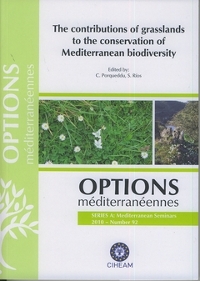| Article précédent | p. 155-159 | Article suivant |
The physiology of drought tolerance in Tedera (Bituminaria bituminosa)
Tedera [Bituminaria bituminosa (L.) C.H. Stirton; Fabaceae] has been used as a traditional forage crop due to its high nutritional value and biomass production with a smaller water demand with respect to alfalfa. In water-limited environments such as southern Spain, different strategies allow the survival of several varieties of tedera. The aim of this work was to determine how four Spanish populations, from differing climatic conditions, respond when faced with drought. A summer field assay was carried out in La Alberca (Murcia, Southern Spain), comparing a watered with a non-watered treatment. Tolerance was expressed as inhibition of shoot growth relative to watered plants. Among the plant physiological parameters that were determined, we observed significant differences between the populations with respect to leaf water potential, osmotic potential, pressure potential, relative water content, specific leaf area, starch, P and K. Under drought, population Albomarginata (Lanzarote) maintained better its growth and its water relations. Population Beal (Murcia) was the most drought-sensitive in terms of growth, perhaps due to its inability to maintain leaf water potential. The behavior of the other two varieties was intermediate.
Tedera [Bituminaria bituminosa (L.) C.H. Stirton; Fabaceae] a été utilisée comme culture fourragère traditionnelle en raison de sa haute valeur alimentaire et de sa production de biomasse nécessitant moins d'eau que celle de la luzerne. Dans des environnements où les ressources en eau sont limitées comme le Sud de l'Espagne, des stratégies différentes permettent la survie de plusieurs variétés de Tedera. Le but de ce travail est de déterminer comment quatre populations espagnoles, sous différentes conditions climatiques, font face à la sécheresse. Un essai estival aux champs a été effectué à La Alberca (Murcia, Sud de l'Espagne), en comparant deux traitements : l'un en irrigué et l'autre pas. La tolérance s'est exprimée sous forme d'une inhibition de la croissance des pousses par rapport aux plantes irriguées. Parmi les paramètres physiologiques de la plante qui ont été déterminés, nous avons observé des différences significatives entre les populations concernant le potentiel d'eau de la feuille, le potentiel osmotique, celui de turgescence, la teneur relative en eau, la surface foliaire spécifique, l'amidon, P et K. En condition de sécheresse, la population Albomarginata (Lanzarote) a mieux maintenu sa croissance et ses paramètres hydriques. La population Beal (Murcia) était sensible à la sécheresse en termes de croissance, ce qui est peut-être dû à son incapacité à maintenir le potentiel en eau de la feuille. Le comportement des deux autres variétés était intermédiaire.
- [ Afficher ]
- [ Télécharger ]
- [ Exporter la citation ]
Vous pouvez télécharger la citation au format :
- [ Imprimer ]
-
Mots-clés
PSORALEA BITUMINOSA, RELATION PLANTE EAU, REPONSE DE LA PLANTE, RESISTANCE A LA SECHERESSECiter cet article
Martínez-Fernández D., Walker D.J., Romero P., Correal E. The physiology of drought tolerance in Tedera (Bituminaria bituminosa). In : Porqueddu C. (ed.), Ríos S. (ed.). The contributions of grasslands to the conservation of Mediterranean biodiversity. Zaragoza : CIHEAM / CIBIO / FAO / SEEP, 2010. p. 155-159. (Options Méditerranéennes : Série A. Séminaires Méditerranéens; n. 92). 13. Meeting of the Sub-Network on Mediterranean Forage Resources of the FAO-CIHEAM International Network for the Research and Development of Pasture and Forage Crops, 2010/04/07-10, Alicante (Spain). http://om.ciheam.org/om/pdf/a92/00801235.pdf



